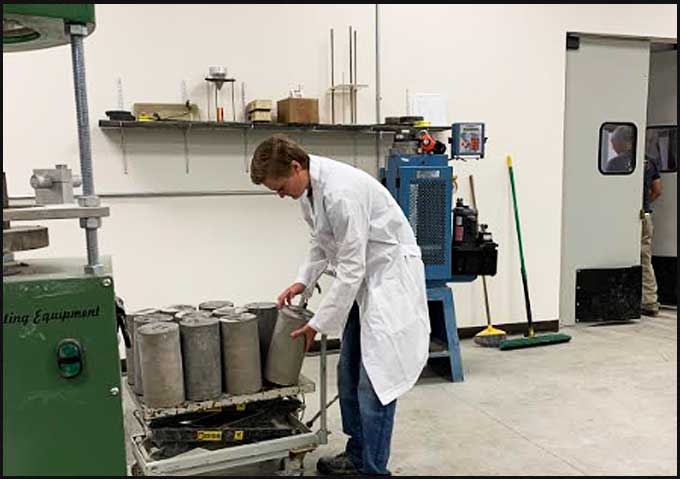Little Known Facts About Material Testing Labs.
Table of ContentsMaterial Testing Labs Can Be Fun For AnyoneThe 8-Minute Rule for Material Testing Labs4 Simple Techniques For Material Testing LabsMaterial Testing Labs - TruthsThe smart Trick of Material Testing Labs That Nobody is Talking AboutThe Ultimate Guide To Material Testing Labs
First setting time is specified as the duration as expiring between the time when water is contributed to the cement as well as the time at which the needle of 1 mm2 section stops working to permeate the examination block to a deepness of regarding 5 mm from all-time low of the mold.Other tests carried out on fresh concrete are: Segregation resistance, System weight, Wet analysis, Temperature, Heat generation, Hemorrhaging The most usual top quality examinations on hard concrete are: The examination of compressive stamina of the concrete cube gives an idea concerning all the residential properties or attributes of the concrete. The test of tensile strength of the concrete is one of the standard & crucial residential properties which generally impact the extent & dimension of fracturing in frameworks.
It is required to establish the tensile stamina of concrete to establish the load at which the concrete participants may split. The modulus of elasticity of concrete is the ratio of stress and anxiety to the stress of the concrete under the application of lots.
Things about Material Testing Labs
As one of one of the most widely secondhand products in construction, concrete demands stringent quality assurance to guarantee its strength as well as long-lasting efficiency. The toughness will certainly rely on many elements, consisting of water-cement proportion, top quality of products and quality assurance during the production of concrete. Below are three typical concrete tests that assist to ensure it meets the required requirements as well as style requirements for its usage.

In three layers, the cone is loaded with the fresh concrete example in an uniform fashion. Each layer is tamped with a steel pole to small the concrete. material testing labs. As soon as filled, any overflow is removed, as well as the concrete is levelled. The cone is after that slowly as well as steadily lifted and put upside-down beside the downturn.
Fascination About Material Testing Labs
The concrete must greatly preserve its cone form, showing that the mix is natural, and also its workability isn't also high. The compressive toughness of concrete an usual efficiency action used by engineers to design structure and also various other frameworks. Compressive stamina is defined as the capability of the concrete to stand up to certain compressive pressures.
In a lab, you can determine the compressive stamina of the concrete using highly controlled round moulds. How it works Concrete examples are put into the cylinders gauging 200mm high and 100mm in size (AS 1012. 9) on-site. When dried out, state the following day, they are then transported to the laboratory, de-moulded and also put into a curing container.
The force requested the sample to stop working (crack/break) is taped. More estimations are carried out to determine the strength compression as well as whether it his response has passed or fallen short the examination. Drying shrinking happens when the concrete structure contracts as a result of moisture/water loss. This can adversely affect the toughness, looks, and serviceability of concrete structures.
Examine This Report on Material Testing Labs
Just how it works Examples are cast into moulds as well as stored in a humid setting till set. The concrete samples are after that de-moulded and also placed in lime saturated water bathrooms and after that a drying out chamber for the duration of the examination. The preliminary analysis is measured at 7 days from time of spreading.
Examining of the concrete plays a vital duty to recognize the stamina, sturdiness as well as condition of the framework. This post is regarding the types of Destructive and also non-destructive examinations done on concrete.
Damaging tests as well as Non-Destructive examinations are done to establish the important homes of concrete like compressive informative post stamina, flexural strength, tensile toughness etc. The high quality of concrete is essential for construction. Hard concrete attains stamina as it matures. The devastating test of concrete helps to comprehend the behaviour and also high quality by damaging the examination sampling at specific loads.
Getting My Material Testing Labs To Work
The destructive testing technique is appropriate and also financially beneficial for the concrete samplings that are created at a large range. The major purpose of damaging tests is to check out the life span and also detect the weakness of design that might not show under typical working conditions. It includes approaches where the concrete specimen is broken so as to identify mechanical properties i.

Quality assurance, Acceptance of concrete, Examination of curing, To offer details on using sand and also aggregate. For reviewing the uniformity of concrete, Quotes the concrete quality with common requirements. To figure out the consistent tension circulation. Investigating the behavior of concrete. For determining the in-place concrete stamina. material testing labs. Age of concrete, and so on.
These tests determine the compressive, flexural and also tensile strength of concrete. Compressive toughness of concrete is the ability of the concrete to hold up against tons without cracking or deformation.
The relevant IS code for this test is IS 516-1959. The lots at which the specimen fails determines its toughness. The unit of compressive toughness of concrete is N/mm2. Clicking Here The test needs to be done at 7, 14 & 28 days. The splitting tensile strength examination is one of the tests on solidified concrete for determining its tensile stamina.